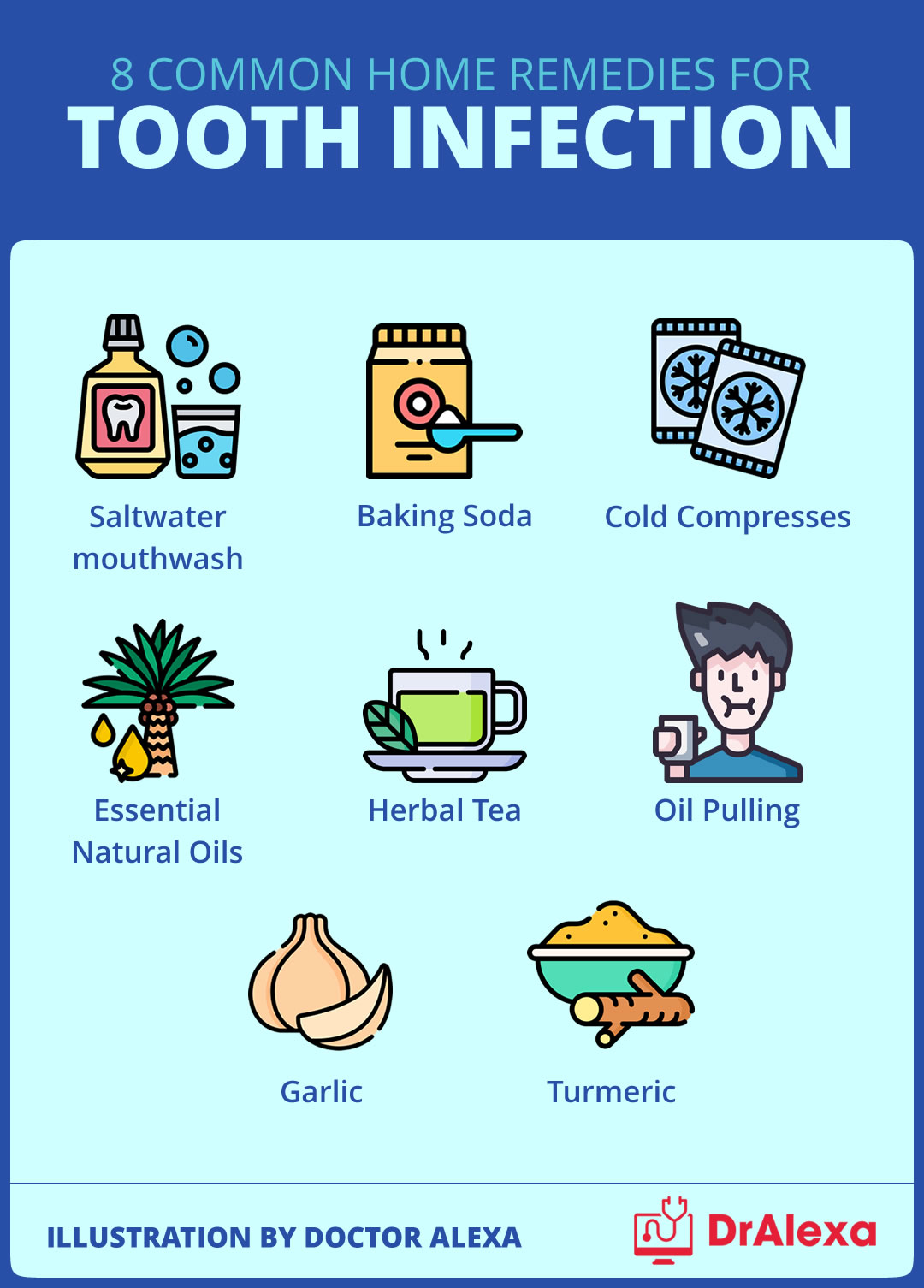Tooth infections can occur for various reasons, including untreated cavities, injuries, tooth decay, or dental work. When this condition arises, patients may experience inflammation and extreme pain. Home remedies for tooth infection can help to keep the pain at bay and control the growth of bacteria in the mouth. But you may wonder: do home remedies work?
If a tooth infection is not treated immediately, the bacteria can spread to other mouth areas, including the gums, nerves, and bones. People with this condition have two options: either consult their dentist and have the issue medically treated or explore remedies at home to ease the symptoms and halt the spread of the infection.
Are Home Remedies for Tooth Infection Beneficial?
Patients with a tooth infection can have difficulty navigating their day-to-day activities without experiencing pain or discomfort. While they may want to visit the dentist to have their condition diagnosed and treated, sometimes, they may not be happy to spend the money or wait a long period before getting relief.
In such cases, home remedies for tooth infections can bring some relief. Home remedies are often inexpensive and widely accessible. In addition, the ingredients to make home remedies are easy to obtain — if not already available. Because of this, it’s often more convenient for patients to explore home remedies before seeing a professional.
Common Home Remedies for a Tooth Infection
Here are some tried-and-tested treatment options patients can try at home to ease tooth pain.
Saltwater mouthwash/Rinse
The first option is for someone with a toothache to rinse their mouth with saltwater. This affordable remedy is considered a universal medicine for tooth and gum pain because it targets the source directly and acts as an antibiotic.
On top of destroying the bacteria in the mouth, this solution can also break down abscesses and pus around the tooth to give the patient immediate relief.
Baking Soda
Like saltwater, baking soda (sodium bicarbonate) also has antibacterial properties that can destroy the bacteria inside the mouth and relieve some pain. Sodium bicarbonate is also an effective ingredient for removing teeth plaque to give patients a brighter and cleaner smile.
Cold Compresses
A cold pack is another home remedy that people can try to ease pain and discomfort. For example, when you experience a tooth infection, there’s a high chance that your cheeks are swollen. In such cases, compression with a cold pack can numb the pain and decrease the amount of swelling.
Patients should put an ice pack over the swollen area for 15 to 20 minutes every few hours for the best results.
Essential Natural Oils
Oils like oregano essential oil are excellent home remedies for tooth infections because they have antioxidant and antibacterial properties. They can reduce the swelling and inflammation of an abscessed tooth while promoting healthier gums.
To use essential oregano oil, dilute the oil with a carrier oil and put a couple of drops on a cotton swab. Then, put the mixture on the affected site for a minimum of 10 minutes before rinsing your mouth. Experts recommend repeating these steps three times a day for optimal results.
Other oils that can work wonders for tooth infection include the following:
- Thyme essential oils
- Clove essential oil
- Lavender oil
- Tea tree oil
- Lemongrass oil
If you don’t have these oils at home, you can easily buy them from organic stores or online retailers.
Herbal Tea
An herbal infusion is a time-tested remedy that can reduce swelling and treat other ailments. One of the most effective herbal infusions is known as fenugreek tea.
Like the other remedies on this list, fenugreek has antibacterial qualities and a long history of healing wounds and controlling inflammation.
But instead of diluting the tea bags in warm water, a better alternative is to preserve the tea’s concentration by heating one cup of water and adding one teaspoon of ground fenugreek to the mixture. Once the mixture is cool enough, apply a small amount to the infected area with a cotton ball and let it remain for a few minutes before rinsing.
You can perform this method thrice a day for the best results. Peppermint tea is also an effective solution.
Oil Pulling
Another ancient method to treat common mouth ailments like tooth infections is a process known as oil pulling.
Many believe this approach can remove toxins from the teeth and gums, eliminate bad bread, reduce bacteria, and treat bleeding gums. There are several good oils for this method, including sesame, raw coconut, and olive oil.
Take about a tablespoon of the oil, swish it around in your mouth for about 10 to 15 minutes, spit out the oil in the trash, and brush your teeth afterward to remove loose bacteria. Be careful not to swallow the oil.
Garlic
Garlic has always been known as a natural remedy with abundant therapeutic benefits — among these are pain relief and killing bacteria.
To benefit from garlic, make a concentrated paste by crushing a clove and rubbing the paste on the affected area. While the experience may initially be uncomfortable, this method reaps positive effects on oral hygiene. Using garlic for oral health can be done multiple times a day.
Turmeric
However, turmeric is an equally effective alternative if you prefer something other than garlic. In addition, turmeric has natural antibiotic and antiseptic properties, making it useful for treating tooth infections at home.
To do this, mix a teaspoon of turmeric with a few drops of water to produce a paste. Once you are content with the consistency of the paste, you can apply this concoction to the affected area and let it remain for a few minutes. After which, you can rinse out the leftover paste. Repeat up to three times a day.

Natural Antibiotic Treatments for a Tooth Infection
Although these home remedies are effective, they tend to be temporary solutions. For maximum impact, patients with a tooth infection need to combine these remedies with natural antibiotic treatment.
Manuka Honey
Although honey generally has antibacterial and antioxidant properties, Manuka honey remains the most potent type of honey to ward off bacteria in the body, including the mouth.
Like garlic and turmeric, Manuka honey has been used as a wound healing and anti-inflammatory remedy for all medical conditions, including tooth infections. To use Manuka honey as a natural antibiotic, consume a spoonful or directly apply the substance to the affected area.
Manuka honey creates a biofilm that will prevent the bacteria from spreading and destroy it.
Ginger
Ginger has beneficial properties, such as glycerol, which gives it its antibiotic effect and is known as a popular spice. In addition, glycerol prevents the reproduction and growth of harmful bacteria in the mouth. Because of this, it can help fight the infection.
There are many ways to use ginger to reduce toothaches. It can be crushed and created into a paste (like garlic). It can also be chewed repeatedly to release the antibacterial content and target the affected area directly.
Aloe Vera Gel
Aloe vera is known to treat cuts and burns, but it can also be used to improve symptoms of dental infections. In addition, it has antibacterial properties and a cooling effect to soothe toothaches and reduce swelling.
To benefit from this remedy, rub the gel on the affected area in the mouth. Patients can also use this herb as a toothpaste or a mouthwash to treat gum disease or lessen inflammation. Besides these, drinking its juice is an excellent way to relieve pain and improve dental care.
Echinacea
Also known as coneflower, Echinacea is dubbed as the “toothache plant” in many Native American cultures because of its antibiotic and antimicrobial agents. To treat toothaches with this herb, experts recommend infusing a few drops with fresh leaves to create a mouthwash concoction. But another way to use this plan is to remove the petals and puree them in a blender to make a paste.
Since only 10 species of Echinacea plants are suitable for human consumption, it’s better to take Echinacea capsules instead of making a paste from scratch. In addition, the capsule option is much safer and more accessible than the traditional method. But regardless, Echinacea in various forms can treat tooth infections effectively.
Grapefruit Seed Extract
Grapefruit seed is highly rich in vitamin C and naringin, a flavonoid that gives the seed its antibiotic properties. Mix 20 drops of the concentrated substance in a half glass of water to use grapefruit seed extract for tooth infection. Then, all you need to do is gargle the mixture like a mouthwash, leaving it in for a few minutes before expelling it.
If the extract is unavailable, mixing the content of two grapefruit seed extract capsules in half a glass of water will work fine. This procedure is safe to do multiple times a day.
Unprocessed Apple Cider Vinegar
Organic or unprocessed apple cider vinegar is another natural antibiotic treatment for dental abscesses. The vinegar itself is acetic acid and promotes bacteriostatic activity that kills bacteria.
It’s important to stress that unprocessed or organic apple cider vinegar is necessary. Choosing mass-produced products that contain additives and other ingredients can hinder the effectiveness of this solution in treating oral conditions.
To use this method, dilute one to two teaspoons of vinegar in water and rinse for a few minutes. It’s important to note that leaving this solution in the mouth for long periods is not suggested because of its bactericidal activity and acidic nature. In addition, there’s a high chance that this solution can cause discoloration in the teeth’ enamel.
Hydrogen Peroxide
Hydrogen peroxide is a popular household item often kept in medicine cabinets. While this solution mainly treats external wounds and burns, it can also treat and prevent tooth infections due to its antiseptic effect.
To achieve the desired effect, dilute it with equal parts warm water and swish it in your mouth for a few minutes. This should be done once or twice a day since it also has strong properties that can damage the enamel and cause discoloration.
Rinsing with this mixture can ease pain and reduce inflammation of the tooth. It can also heal bleeding gums and treat symptoms of gum disease.
Avoid swallowing this solution, as doing so can lead to an upset stomach, vomiting, and throat irritation. On the other hand, ingesting pure, undiluted household dihydrogen dioxide can burn one’s internal organs and induce internal bleeding.
For a safer (but milder) option, people can explore mouthwashes with high hydrogen peroxide content. These are often used as antibacterial and antiviral treatments in at-home and professional settings. Although this alternative may not be as strong or potent as its household counterpart, it’s less risky.
Can You Get Cure a Tooth Infection Without Going to the Dentist?
Because bacterial growth is the primary cause of tooth infections, antibiotics are the only way to treat them. Because of this, the highlighted home remedies and natural treatment options can eliminate dental problems without going to the dentist.
However, if symptoms persist and the tooth infection worsens after exploring these home remedies, the next step is to visit the dentist.
When To Visit the Dentist
While an abscessed tooth usually starts in just one area of the mouth, the bacteria can spread to other facial areas, including the jaw and eyes, if left unattended over a long period. As such, patients experiencing extreme pain or discomfort due to this condition are recommended to see a specialist if the symptoms do not decrease after a few days or weeks.
It’s also crucial to remember that while the home remedies mentioned above are effective, they work best when combined with doctor-prescribed treatments, such as more potent antibiotics and dental care.
How the Dentist Can Treat Tooth Infection
In extreme conditions, the dentist will diagnose the patient’s tooth infection and conduct the appropriate treatment methods to remove the disease entirely.
Typically, the dentist will apply anesthesia to numb the pain and drill the areas of infection to clear out the abscess or pus within the affected area. If there are abscesses in the gums or near the tooth, the dentist will also clean these pockets to prevent the bacteria from spreading. The dentist can perform root canal operations to save the infected tooth if necessary.
Of course, these methods are typically a last resort. However, practicing proper oral hygiene is the best way to keep teeth healthy and away from infection.
After treating this condition, good dental hygiene is the best preventive measure to prevent recurring toothaches and infections.
Read Also: Everything You Need to Know About Antibiotics for Tooth Infection
Frequently Asked Questions (FAQs)
Among the remedies listed above, saltwater rinse is the best home solution for tooth abscesses. In addition, saltwater can heal wounds and remove bacteria through a process called osmosis.
The sodium chloride draws the liquid from its contact area during this process. Therefore, in case of a tooth abscess, the salt from the solution will not only extract the build-up of moisture but, more importantly, eliminate the bacterial aspects to effectively and efficiently cleanse the area.
The relief from this method should happen instantaneously. However, it’s best to repeat this method thrice daily for longer-lasting results until the pain significantly subsides.
Aside from being a fast solution to tooth abscess pain, a saltwater wash is also the most accessible and affordable option from the list since almost everyone has salt and water at home.
A cold pack compress or ice is one of the best ways to numb pain in the tooth overnight. A cold treatment on the affected area can constrict the blood vessels, slowing blood flow to the infected tooth. As a result, a cold compress or a bag of ice can numb the nerves and reduce inflammation and swelling.
For this to work, drop one or two ice cubes in a disposable plastic bag and put them on the painful area. While the compress numbs the spot, you must avoid drinking or eating anything sweet, as doing so will only reverse the effect and increase the pain.
Aside from sodium bicarbonate and saltwater, patients with abscessed teeth can use natural remedies like coconut oil, clove oil, turmeric, garlic, ginger, apple cider vinegar, and Manuka honey.
If you want something more potent, consider over-the-counter painkillers like naproxen, aspirin, and acetaminophen to manage the pain and control the infection better. However, because medications like painkillers are potent and concentrated, their effects can be substantial. Therefore, you must follow instructions carefully and take, at most, the prescribed dose.
Plus, if they want further assurance, they can consult their doctor or healthcare provider before purchasing painkillers over the counter.
Home treatments for tooth infections are varied. From salt water rinses to sodium bicarbonate pastes to natural antibiotics and everything in between, individuals with a tooth infection have numerous options available to treat their condition at home.
They can combine these remedies to get the desired results depending on what they can access and are comfortable with. Instead of limiting themselves to saltwater mouthwashes, for example, they can combine it with herbal infusions at night to enhance their healing effects on their infected teeth or gums.
Likewise, they can even try out different natural remedies, like turmeric, ginger, and garlic, to see which works best for their case.
Besides the remedies mentioned above, you can apply alcohol like whiskey, vodka, or scotch to the affected area to numb the pain. These substances have anesthetic properties, which work similarly to painkillers and relieve discomfort.
As much as possible, patients can try home remedies as soon as they start experiencing pain from a tooth infection. If left untreated, the condition will inevitably spread to the surrounding tissues in your mouth and around the face, wreaking havoc on one’s oral hygiene and overall well-being.
Although there is no precise timeline for when bacteria will start to spread, this process typically takes weeks or months before impacting other areas of the mouth and face. This will ultimately depend on how nasty the infection is, which areas are affected, and how long ago it was discovered.
Every patient has a different experience, so there’s no definite duration. But in any case, there are other options than waiting until the last window to do something about the infection. If early signs appear, you should perform home remedies immediately to prevent the situation from worsening.
Otherwise, you may need more extreme — as well as risky and expensive(even with dental insurance) — approaches to treat your tooth infection.





